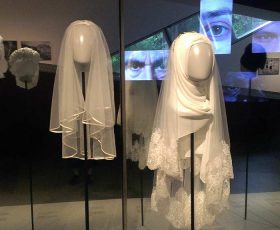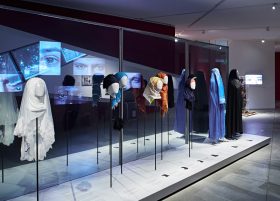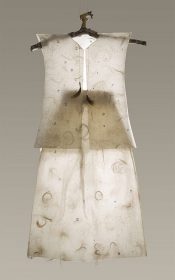The Italian Writer Elena Loewenthal Reflects on Strong Jewish Women in the Torah
The current exhibition Cherchez la Femme, which explores religious dress codes for women from women’s perspectives, remains on display until 27 August (more about the exhibition on our website). When I first found out the exhibition’s theme, I immediately thought of the novel Attese (2004) by the Italian author Elena Loewenthal. (The title means either “expectations” or “times of waiting.”) In four extended sections, the novel tells the stories of different Jewish female characters throughout the ages. But the novel’s real main character is a mysterious veil that follows the protagonists from Biblical times to modern-day Venice.

Veils in the exhibition Cherchez la femme; Jewish Museum Berlin, photo: Mirjam Bitter
We can read the veil as a metaphorical vessel of Jewish memory that women have guarded and passed on, a vessel that embodies recollection and forgetting, tradition and renewal. Indeed, the reasons each woman in the novel dons the veil are not only cultural (such as marking mourning) but personal: each of them reshapes it, sews in her own threads, or at least cultivates an idiosyncratic relationship with the garment she inherited. → continue reading
Our visitors on Cherchez la femme
For over three months, the exhibition Cherchez la femme has allowed visitors to explore the topic of women’s head coverings in three of the world’s major religions. Among other things, the exhibition demonstrates that the borders of (religious) clothing rules are constantly being redrawn and reinterpreted.
Since we’re very interested in the opinions of our visitors, we asked around about what people thought at the exhibition:
Christian (39), Ludwigsburg, pastor, teaches German and history
Which object did you like the best?

Different kinds of head coverings; Jewish Museum Berlin, photo: Yves Sucksdorff
The gallery with the different kinds of head coverings. I was impressed by the attention to detail. For example, I didn’t know how many differences
there were between headscarves, between Turkish and Arab styles.
What significance does your own hair have to you?
It’s important to me that I look good. I go to the barber regularly.
Would you say that you follow any clothing rules? → continue reading
Artist Andi Arnovitz Questions Traditional Matrimonial Law

The Dress of the Unfaithful Wife by Andi LaVine Arnovitz, 2009; photo: Avshlom Avital
In our current exhibition, Cherchez la femme, a transparent dress seems to reveal everything. The Israeli-American artist Andi LaVine Arnovitz created a delicate work of art from washi paper, hair, and Hebrew letters. Locks of hair adorn the paper dress, hinting at the beauty of its wearer. But how to interpret the other components, the grime and coarse body hair?
The individually placed letters are the key to understanding this piece. They point to the biblical ritual described in the Torah, Numbers 5: 11–31, on which this work is based: → continue reading


